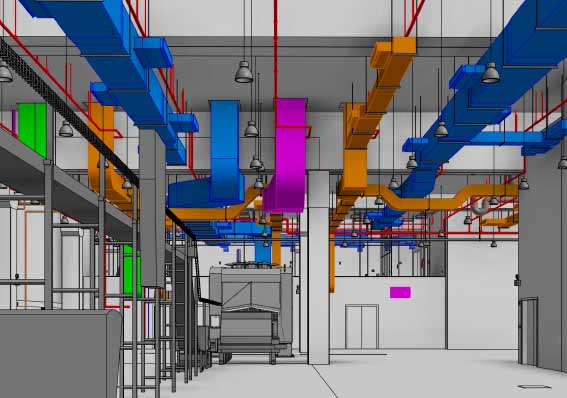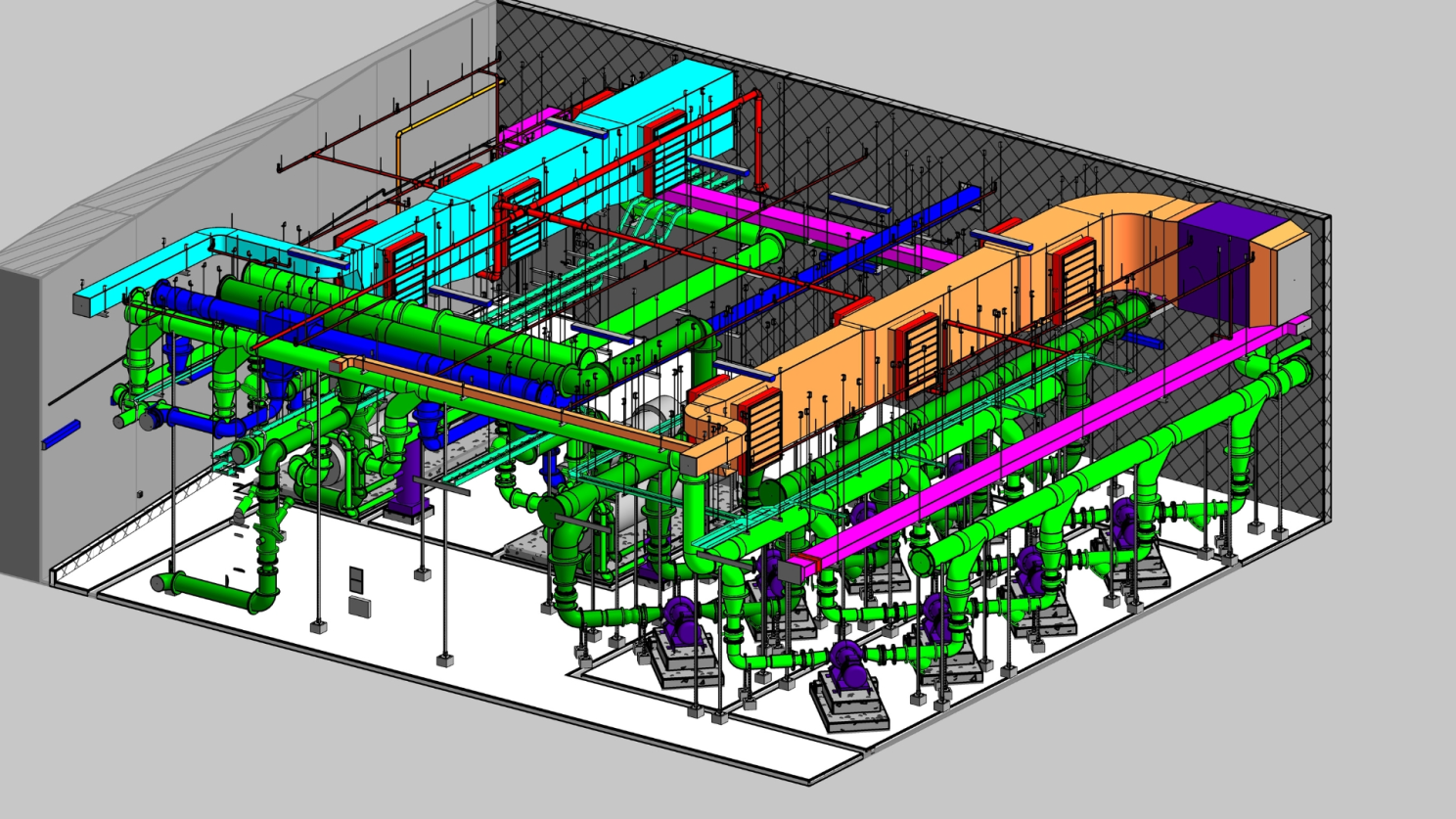
Building Information Modeling (BIM) has revolutionised the construction and design industry, offering a more efficient and collaborative approach to building projects. For an MEP Design Engineer, BIM is particularly crucial as it helps integrate mechanical, electrical, and plumbing systems seamlessly within a building structure. The ability to visualise, analyse, and coordinate these systems reduces design errors, enhances efficiency, and ensures optimal project execution.
In modern construction, the role of an MEP Design Engineer has evolved significantly. Traditional 2D drafting methods are being replaced by advanced BIM modeling software, which provides 3D visualisation, real-time analysis, and better coordination between different project stakeholders.
With the adoption of BIM-related software, MEP professionals can detect and resolve clashes early in the design phase, reducing costly errors and rework. MEP in BIM ensures that all building systems function efficiently, leading to better project execution and sustainable infrastructure development.
What is BIM for MEP Design Engineers?
BIM for MEP Design Engineers refers to the process of designing and managing mechanical, electrical, and plumbing systems using BIM-related software. This technology provides detailed 3D models, real-time simulations, and precise data for decision-making. MEP in BIM ensures that all building services function harmoniously, avoiding clashes and reducing project delays.
A major advantage of using BIM MEP software is improved coordination among various building systems. By leveraging BIM modeling software, engineers can conduct clash detection, reducing on-site errors and ensuring that all MEP components work harmoniously. This results in a streamlined construction process with fewer delays and cost overruns.
Why MEP Design Engineers Should Use BIM?
There are several reasons why every MEP Design Engineer should adopt BIM:
1. Improved Accuracy and Reduced Errors
One of the biggest advantages of using BIM modeling software is its ability to detect and prevent design errors early. Traditional 2D drafting methods often lead to misalignment of systems, causing costly rework. With BIM-related software, engineers can visualise and analyse potential clashes before construction begins, ensuring optimal design accuracy.
2. Enhanced Collaboration and Coordination
MEP in BIM allows multiple teams, including architects, structural engineers, and MEP specialists, to collaborate efficiently on a single platform. BIM MEP software enables real-time data sharing, ensuring that all stakeholders stay informed and aligned, reducing project delays and miscommunication.
3. Cost and Time Efficiency
By leveraging BIM-related software, MEP Design Engineers can automate calculations, optimise resource allocation, and streamline project workflows. This significantly cuts down the time spent on manual drafting and revisions, leading to faster project completion and lower costs. As a result, companies that implement BIM MEP software often experience higher profitability and reduced waste.
4. Better Lifecycle Management
Beyond construction, BIM modeling software helps with the entire building lifecycle. Facility managers can use BIM-generated models for maintenance planning, energy efficiency analysis, and infrastructure upgrades. This long-term benefit makes BIM in MEP an indispensable tool for sustainable building management.
5. Career Growth and Higher Salaries
Professionals skilled in BIM MEP software are in high demand, leading to better career opportunities. The MEP Design Engineer salary is significantly higher for those specialising in BIM, as companies prioritise candidates with expertise in BIM-related software. Additionally, organisations are investing in training programs to upskill their workforce in BIM MEP modeling.
Key Applications of BIM in MEP Design

Building Information Modeling (BIM) has revolutionised Mechanical, Electrical, and Plumbing (MEP) design by enhancing accuracy, efficiency, and collaboration. By integrating BIM technology into MEP design, professionals can streamline workflows, minimise errors, and improve project outcomes.
1. Enhanced Collaboration and Coordination
BIM allows MEP engineers to work seamlessly with architects, structural engineers, and other stakeholders. This integrated approach reduces design conflicts and ensures smooth project execution.
2. Clash Detection and Conflict Resolution
One of the primary benefits of BIM in MEP design is automated clash detection. By identifying and resolving conflicts between MEP components and structural elements early in the design phase, BIM prevents costly rework and project delays.
3. Energy Efficiency and Sustainability
BIM facilitates energy analysis and sustainability planning in MEP systems. Engineers can use BIM models to optimise HVAC, lighting, and water systems for better energy performance, reducing operational costs and environmental impact.
4. Accurate Cost Estimation and Material Management
With BIM, precise cost estimation and material take-offs become more efficient. The technology enables MEP professionals to generate accurate quantity estimations, reducing material wastage and ensuring budget adherence.
5. Improved Maintenance and Facility Management
Post-construction, BIM serves as a valuable asset for facility management. Digital MEP models provide detailed information on system components, making maintenance, repairs, and future upgrades more efficient.
BIM continues to reshape the MEP industry, providing professionals with advanced tools to enhance efficiency, reduce risks, and drive innovation in building design and construction.
Top BIM Software for MEP Design Engineers

In the modern construction industry, MEP design engineers rely on advanced BIM software to enhance project efficiency and accuracy. With the growing demand for skilled professionals, expertise in BIM MEP software is essential for securing high-paying MEP design engineer jobs and improving career prospects.
Leading BIM Software for MEP Engineers:
- Revit MEP – A widely used BIM modeling software that offers powerful tools for MEP BIM modeling, enabling precise design and seamless collaboration.
- AutoCAD MEP – Designed specifically for MEP engineers, this BIM-related software streamlines drafting and documentation processes.
- Navisworks – Essential for MEP in BIM, this tool helps engineers conduct clash detection, project visualisation, and coordination with other disciplines.
- Bentley AECOsim – A robust BIM software that enhances multi-disciplinary collaboration and optimises building performance.
- Trimble Nova – A user-friendly BIM MEP software that integrates smart calculation features for MEP BIM modeling.
Benefits of BIM Software for MEP Design Engineers:
- Enhances accuracy and reduces errors in BIM MEP software workflows.
- Improves collaboration among teams, ensuring smoother project execution.
- Helps professionals command a higher MEP design engineer salary by mastering industry-relevant tools.
- Offers better job opportunities, as expertise in BIM-related software is increasingly valued by top firms.
Benefits of Using BIM for MEP Engineers
The adoption of BIM software has significantly improved efficiency, accuracy, and collaboration for MEP design engineers. By integrating BIM MEP software, professionals can enhance their design processes, minimise errors, and optimise building performance. With increasing demand for skilled engineers, mastering BIM-related software can lead to better MEP design engineer jobs and higher MEP design engineer salaries.
Key Benefits of BIM for MEP Engineers:
- Improved Clash Detection: Helps identify and resolve conflicts in MEP BIM modeling, reducing costly errors and rework.
- Enhanced Collaboration & Coordination: Ensures seamless data exchange and teamwork among architects, structural engineers, and MEP professionals.
- Increased Design Accuracy: Tools like Revit MEP and AutoCAD MEP improve precision in BIM modeling software, leading to better project outcomes.
- Optimised Resource Management: Enables efficient material usage, reducing waste and overall project costs.
- Better Project Visualisation: Software like Navisworks supports 3D visualisation and project reviews for improved decision-making.
- Sustainability and Energy Efficiency: Supports eco-friendly designs and performance analysis for greener construction solutions.
- Career Growth Opportunities: Mastering BIM in MEP can increase job prospects, enhance expertise, and lead to competitive salaries in the industry.
Challenges in BIM Adoption for MEP Engineers & How to Overcome Them
Despite its advantages, BIM adoption faces several challenges:
- High Initial Investment: Investing in BIM-related software can be expensive.
- Learning Curve: Engineers must upskill to use BIM MEP software effectively.
- Resistance to Change: Traditional methods are still preferred in some firms.
How to Overcome These Challenges:
- Training & Certification: Enroll in specialised BIM courses.
- Gradual Implementation: Start with smaller projects before full-scale adoption.
- ROI Analysis: Demonstrate long-term cost savings to stakeholders.
Career Growth & Salary Trends for BIM MEP Design Engineers
The demand for MEP Design Engineers proficient in BIM is rising.
- The MEP Design Engineer's salary varies based on experience and location.
- In India, an entry-level MEP engineer salary ranges between ₹3-6 LPA, while experienced professionals can earn up to ₹15 LPA.
- MEP Design Engineer jobs are in high demand across the construction, infrastructure, and real estate industries.
How Novatr’s BIM MEP Course Helps MEP Engineers Excel in BIM Workflows
With the growing demand for skilled MEP design engineers, expertise in BIM software is essential for career advancement. Novatr’s BIM MEP course is designed to equip professionals with hands-on experience in leading BIM MEP software, helping them master MEP BIM modeling and stay competitive in the industry.
Key Benefits of Novatr’s BIM MEP Course:
- Comprehensive Training: Covers industry-leading BIM modeling software like Revit MEP, AutoCAD MEP, and Navisworks, ensuring engineers gain practical knowledge.
- Mastering MEP in BIM: Teaches efficient MEP BIM modeling techniques to enhance project coordination and reduce design errors.
- Improved Career Opportunities: Knowledge of BIM-related software enhances job prospects, making it easier to secure high-paying MEP design engineer jobs.
- Higher Salary Potential: Professionals skilled in BIM MEP software and BIM workflows are more likely to achieve a competitive MEP design engineer salary.
- Real-World Applications: Provides hands-on projects to help engineers understand the benefits of BIM and its impact on real-world construction.
- Industry-Recognised Certification: Helps professionals validate their expertise in BIM technology and improve their job market value.
Conclusion
BIM is transforming the way MEP Design Engineers approach building projects. From improving efficiency to reducing costs, the adoption of BIM MEP software is a game-changer. With specialised training, engineers can secure better career opportunities, increase their MEP engineer salary, and stay ahead in the competitive job market. Investing in BIM is no longer an option—it’s a necessity for modern MEP engineers.
Whether you are an aspiring professional or an experienced engineer, mastering MEP in BIM can elevate your career to new heights. Among the best options, the BIM Professional Program for MEP Engineers by Novatr stands out the most. For the latest updates, tools, and insights into the MEP and BIM industry, explore Novatr's Resource Page.
FAQs
Q1: What are the key benefits of BIM for MEP design engineers?
Ans: BIM software enhances accuracy, collaboration, and efficiency in MEP BIM modeling by enabling real-time coordination, reducing errors, and optimising resource management. It improves clash detection, enhances project visualisation, and supports sustainability. These benefits lead to cost savings, reduced rework, and smoother project execution in MEP design engineering workflows.
Q2: What is the salary of an MEP design engineer?
Ans: The MEP design engineer salary varies based on experience, location, and expertise in BIM software. Entry-level salaries range from ₹3-5 LPA in India, while experienced engineers with BIM MEP software skills can earn ₹8-15 LPA or more. In developed countries, salaries range from $60,000 to $100,000 annually.
Q3: Which BIM software is commonly used in MEP design?
Ans: Revit MEP, AutoCAD MEP, and Navisworks are widely used BIM MEP software for MEP BIM modeling and project coordination. Other BIM-related software includes Bentley AECOsim and Trimble Nova, which help improve design precision, optimise building performance, and enhance collaboration among project teams.
Q4: Why should MEP design engineers adopt BIM in their workflows?
Ans: MEP in BIM ensures better design accuracy, early conflict detection, and improved construction efficiency. It streamlines MEP design engineer workflows by integrating real-time data sharing, reducing project delays, and enhancing collaboration. Additionally, mastering BIM MEP software can lead to higher salaries and better job opportunities in the AEC industry.
Q5: What career opportunities are available for MEP engineers with BIM expertise?
Ans: Professionals skilled in BIM modeling software can pursue high-paying MEP design engineer jobs as BIM Coordinators, BIM Managers, or MEP Consultants. Companies prioritise candidates with BIM-related software experience for roles in design firms, construction companies, and multinational corporations, ensuring strong career growth and job security.
Was this content helpful to you



.jpeg)



